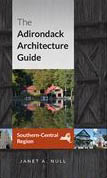News & Updates
A new tour for The Adirondack Architecture Guide: Eastern Region has just been posted—the incredible Hamlet of Essex!
Also recently posted is the essay "Settlement in the Adirondacks", which provides an essential overview of the geography, settlement patterns and periods, and the industries that built Adirondack communities. Look for additional segments of the Eastern Region later in the spring.
And—for a limited time only—we have posted the longest tour from The Adirondack Architecture Guide: Southern-Central Region (SUNY Press, 2017), which presents a fascinating cross-section of architecture, traveling from the southwest through to the heart of the Adirondacks.
Book Review by Wes Haynes
"... the guide succeeds as exemplary in presenting a difficult region's built diversity accurately and with substance and authority." See the full review by Wes Haynes from the APT International Bulletin here.
Facebook:
Visit the Facebook page for the latest news, conversation and Featured Buildings from The Adirondack Architecture Guide. Janet Null on Facebook
Preview the Eastern Region:
Preview the upcoming Eastern Region of the Guide by clicking on the key map or Eastern Region Tours, and in the Preview Photos. Select tours will be available for download beginning this spring.
Buy the Guide:
The Adirondack Architecture Guide, Southern-Central Region is available through Amazon, Barnes and Noble, SUNY Press, and local bookstores. E-book editions are available from the Kindle Store or Google Play.
Northern Region
Suggestions for sites to include in the Northern Region book are still being accepted. Click on "Suggest a property" under Participate in the Guide.
Download a Tour
Download selected, unabridged Tours in the Southern-Central Region to enjoy immediately. Continue to monitor this space for periodic posting of new and different Tours to download.
Tour D-1: Hamlet of Essex 2.0 mb
Essex was a powerhouse Lake Champlain port in the 1800s, a hub of both commercial shipping and ship building, which retains important maritime structures and is home to the oldest continuously operating ferry service on the lake (started c.1791). The hamlet is recognized now as one of the most intact concentrations of Federal and Greek Revival period architecture in the nation, with 90% of its pre-Civil War buildings still standing, thanks in large part to vigorous and persistent local preservation efforts.
Tour C: Woodgate to Blue Mountain Lake 9.6 mb
The tour follows the main route, NY Route 28, from the southwest edge of the Park all the way through to the center of the Adirondacks. It features an amazing range of historic site and buildings from historic train stations and hotels, to singular rural churches, industrial sites and bridges, fun roadside architecture, the camps of the Fulton Chain Lakes, and the preeminent Adirondack Great Camp, Sagamore. It's truly a cross section of Adirondack architecture.
Download an Essay
Providing architectural-historical context for the Guide Tours, essays by invited authors discuss architects and designers, Adirondack building types, and cultural or geographic developments that shaped the settlement and architecture of the Adirondack Park. Monitor this space for new and different essays.
Settlement in the Adirondacks 7.2 mb
Author: Janet A. Null
Geography is destiny in the Adirondacks. Get an overall understanding of the geography and settlement patterns in this essay—where and why people settled, and the industries that drove the formation of Adirondack communities.
Rocks and Trees: Adirondack Building Materials 0.2 mb
Author: Janet A. Null
Historically, Adirondack designers and builders relied on native materials. Learn about the typical local materials and their use for both practical and aesthetic reasons—including the stone, logs, branches, and bark that were integral to the Adirondack Rustic Style.
Notable Links
The Adirondack Architecture Guide was featured in an article by Leigh Hornbeck in the Albany Times Union on December 6, 2015. You can read Architectural field guide highlights man-made wonders of the Adirondacks by Leigh Hornbeck on Timesunion.com.
Seneca Ray Stoddard historic photographs collection at the Chapman Historical Museum
Participate in the Guide
Join the experts on Adirondack culture and heritage, Town and County Historians, local residents, volunteer reviewers and others who are participating in developing an inclusive, accurate, and engaging guide to the diverse architecture of the Adirondack Park. Share your feedback, knowledge and suggestions by clicking the closest subject heading for your message.
